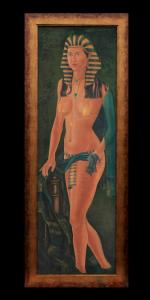Looking for design inspiration? Browse our curated collections!
April 6th, 2015 - 12:33 PM

REALISM OF ART
Realism emerged in the art world in the 19th century in Europe. Artists moved away from the Age of Reason of the 18th century to a new need for creating art with historical and realistic accuracy. According to Honour and Fleming, the moderate painters of France were known as the juste milieu, or the happy medium. They painted in a style that “demanded detail – local color in a literary as well as in an artistic sense – and detail rendered with illusionistic veracity; the button-hole of a cloak, the pommel of a dagger.”
Some works of art in the Realist period echo the styles of earlier centuries, including Classical, Renaissance, Baroque, and Romantic principles. Some Realists felt they were breaking with academic principles of art. Gustave Courbet (1819-1877) was a French painter who embodied the historic nature of Realism. He moved on from the self-articulated “trappings of Romanticism.” His first prominent work, A Burial at Ornans, was completed in 1850-1851. This painting arranges a community of people around a countryside burial site, complete with a Catholic priest, altar boys, and a deacon carrying a crucifix. The crowd is arranged in vivid detail around the central burial site. The human expressions are somber in keeping with the event.
As another leading Realist, Edouard Manet (1832-1883), shows a very different style in painting that would soon give way to Impressionism. Manet painted humans in natural settings like Luncheon on the Grass (1863). In this composition, a pale, naked woman lounges beneath the trees in the company of two well-dressed gentlemen. In the background, another woman clad in a white nightgown bends over the grass in deep thought. An oil on canvas, Luncheon on the Grass shows the influences of great painters like Raphael, but the artistic style is still groundbreaking.
In the United States, Realists also continued the true depiction of subjects. With Madame X (1884), John Sargent (1856-1926) presents a beautifully-endowed woman with creamy skin. She turns to the left away from the audience. Dressed in a black formal gown, her delicate hand rests on a short table. This painting shows how the depiction of human forms differed from, but also echoed, the 17th century works of painters like Rembrandt and Peter Paul Rubens.
When you consider works of art from the Realist period in the nineteenth century, you are not yet prepared for Monet’s sudden breakthrough called Impressionism. One might argue that Edouard Manet’s works suggest the new style, but avant-garde artists such as the Impressionists would naturally continue with tradition, including Manet’s theme of bourgeois relaxing in the park. Realism / naturalism in the arts is the attempt to represent subject matter truthfully, without artificiality and avoiding artistic conventions, implausible, exotic and supernatural elements.
Realism has been prevalent in the arts at many periods, and is in large part a matter of technique and training, and the avoidance of stylization. In the visual arts, illusionistic realism is the accurate depiction of lifeforms, perspective, and the details of light and colour. Realist works of art may emphasize the ugly or sordid, such as works of social realism, regionalism
There have been various realism movements in the arts, such as the opera style of verismo, literary realism,theatrical realism and Italian neorealist cinema. The realism art movement in painting began in France in the 1850s, after the 1848 Revolution.[1] The realist painters rejected Romanticism, which had come to dominate French literature and art, with roots in the late 18th century.From 1400 to 1800, Western art was dominated by Renaissance-inspired academic theories of idealized painting and high art executed in the Grand Manner. Thereafter, caused partly by the huge social changes triggered by the Industrial Revolution, there was a greater focus on realism of subject - that is, subject matter outside the high art tradition. The term Realism was promoted by the French novelist Champfleury during the 1840s, although it began in earnest in 1855, with an Exposition by the French painter Gustave Courbet (1819-77), after one of his paintings (The Painter's Studio) had been rejected by the Universal Exhibition. Courbet set up his own marquee nearby and issued a manifesto to accompany his personal exhibition. It was entitled"Le Realisme".
Comments
There are no comments on this blog. Click here to post the first comment.